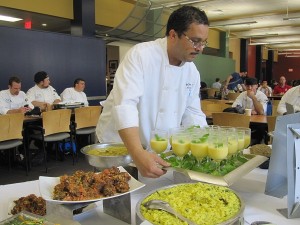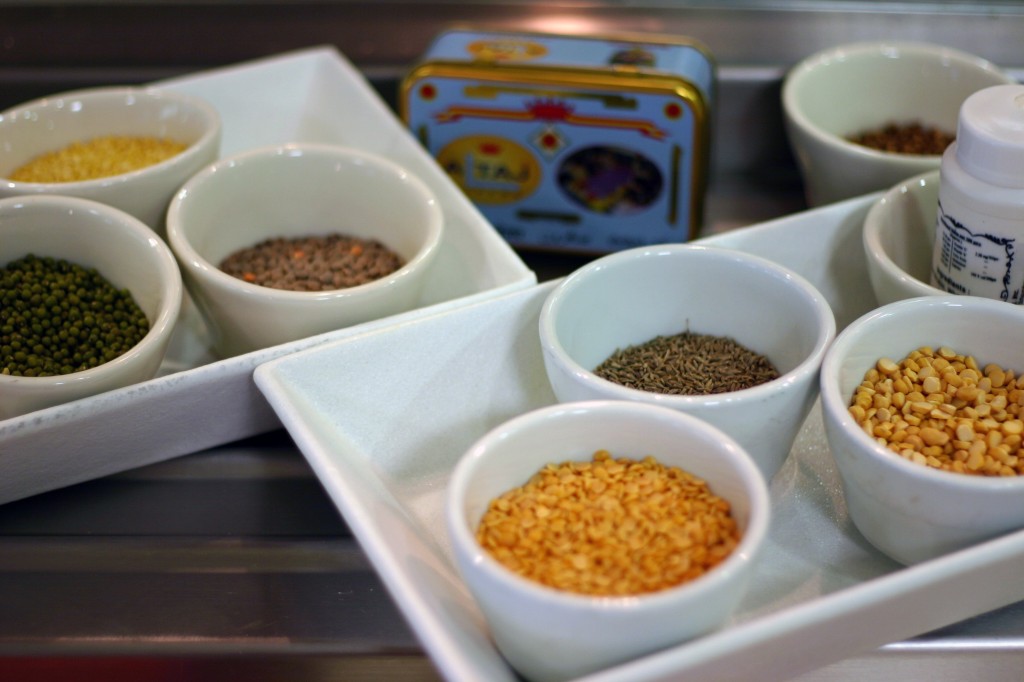Lessons Learned on the Turmeric Trail
This summer, Bon Appétit chefs gathered around the country to learn the ins and outs of cooking authentic Indian cuisine. At Emmanuel College in Boston, I joined a group of New England chefs attending the culinary training, titled “Flavors from the Turmeric Trail” and given by Raghavan Iyer, a native of Mumbai and a celebrated chef, author, and teacher.
Until that day, I had no idea that the majority of Indian cooking in America represents only the northwest corner of India. I was shocked when Raghavan explained that the word “curry” does not belong to any of the 16 languages spoken in India and that its meaning has nothing to do with the spices or herbs in a dish. Instead, it simply indicates that a dish contains a sauce or gravy.
Under Raghavan’s direction, our chefs unleashed flavors I didn’t know existed using simple, high-quality ingredients and precise techniques. As the only non-chef at the training, I absorbed only bits of the information conveyed but left with a full appreciation of the variety that Indian cuisine can offer:
- Each spice used in Indian cooking can have eight completely distinct flavors, depending on how the seed is used: raw seed used whole, raw seed ground finely, dried toasted seeds used whole, dried toasted seeds ground finely, seeds sautéed in a fat (like oil) and used whole, or the same but ground finely, and lastly, seeds soaked in a liquid and then used whole or ground. Change the fat or liquid, and you change the flavor even more dramatically.
- Never judge a spice by the way it smells or tastes: Each dish has a balance within it, and each spice needs to be combined with the rest of the flavors and textures in the dish (and cooked) before it can be judged or evaluated.
- The thickness of a chili determines its heat level: the thicker the chili, the more mild it is. Thin chilies have the strongest heat. Do not remove the seeds (ever!) if cooking Indian food — there is a chemical in them that gives the feeling of heat to a dish.
- Know your legumes: Understand the differences between lentils and don’t casually substitute between them in Indian cooking. There are different varieties, and different ways of processing them: skinned, not skinned, split, not split — and each cook differently. If a lentil is labeled “dal” that means it’s split already and will have a much shorter cooking time than a non-split lentil.
- All sesame oil isn’t created equal: Most sesame oil in the U.S. is “toasted” sesame oil, which should never be used in Indian cooking. Look for raw sesame oil, which has a milder flavor.
- Understand the purpose of each ingredient: Tamarind, for example, is found in coastal areas of India and is used as a souring agent in dishes. If you don’t have access to tamarind you can substitute lime or lemon juice, but the flavors will not be nearly as complex.
- Rice substitutions: If you’re making rice with spices/flavors and you want to substitute brown rice for white rice, it’s possible but it’s not a direct substitute. Because of the qualities of brown rice (primarily its different texture), the subtle spices will be harder to discern. You’ll need more of everything to get the same flavor from the dish.
Although this information may be common knowledge for those familiar with Indian culture, for this young, American lover of food — and even for many chefs at Bon Appétit — these points came as (very useful) news!

